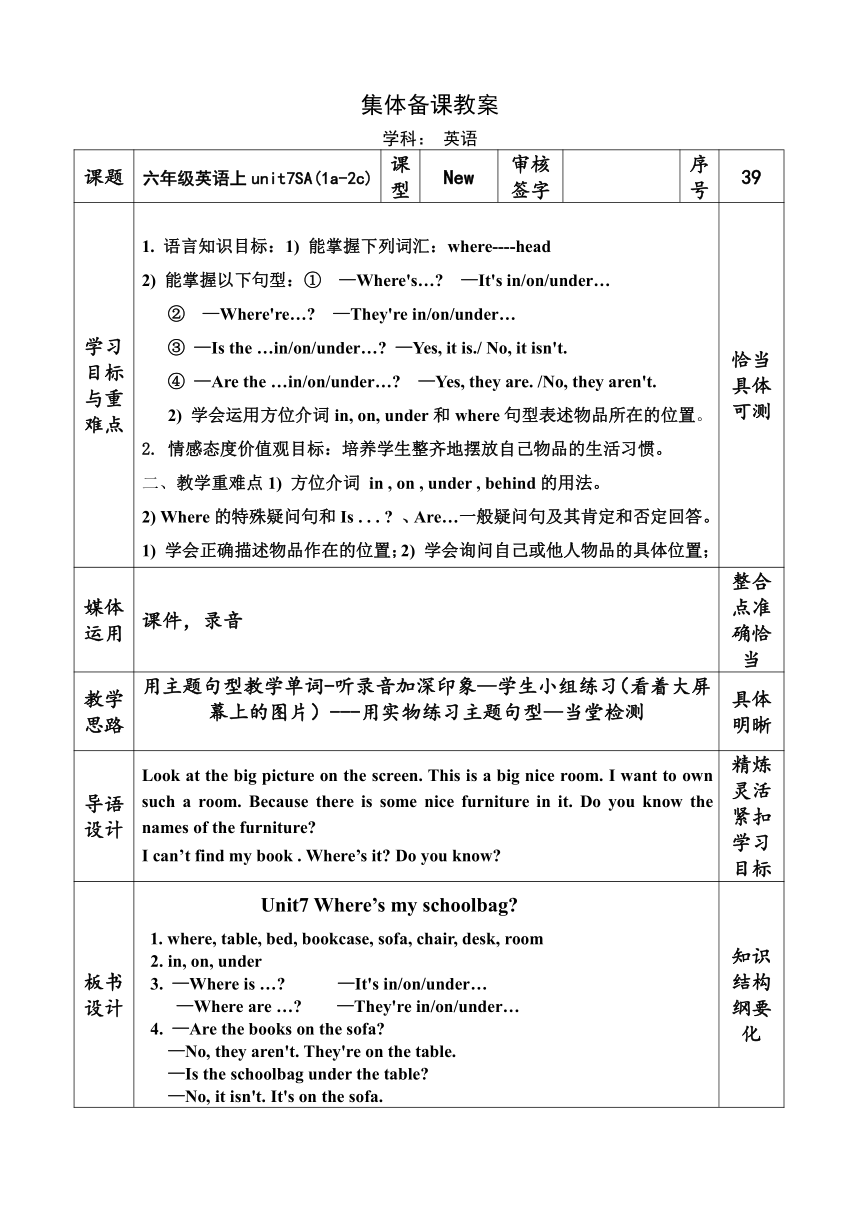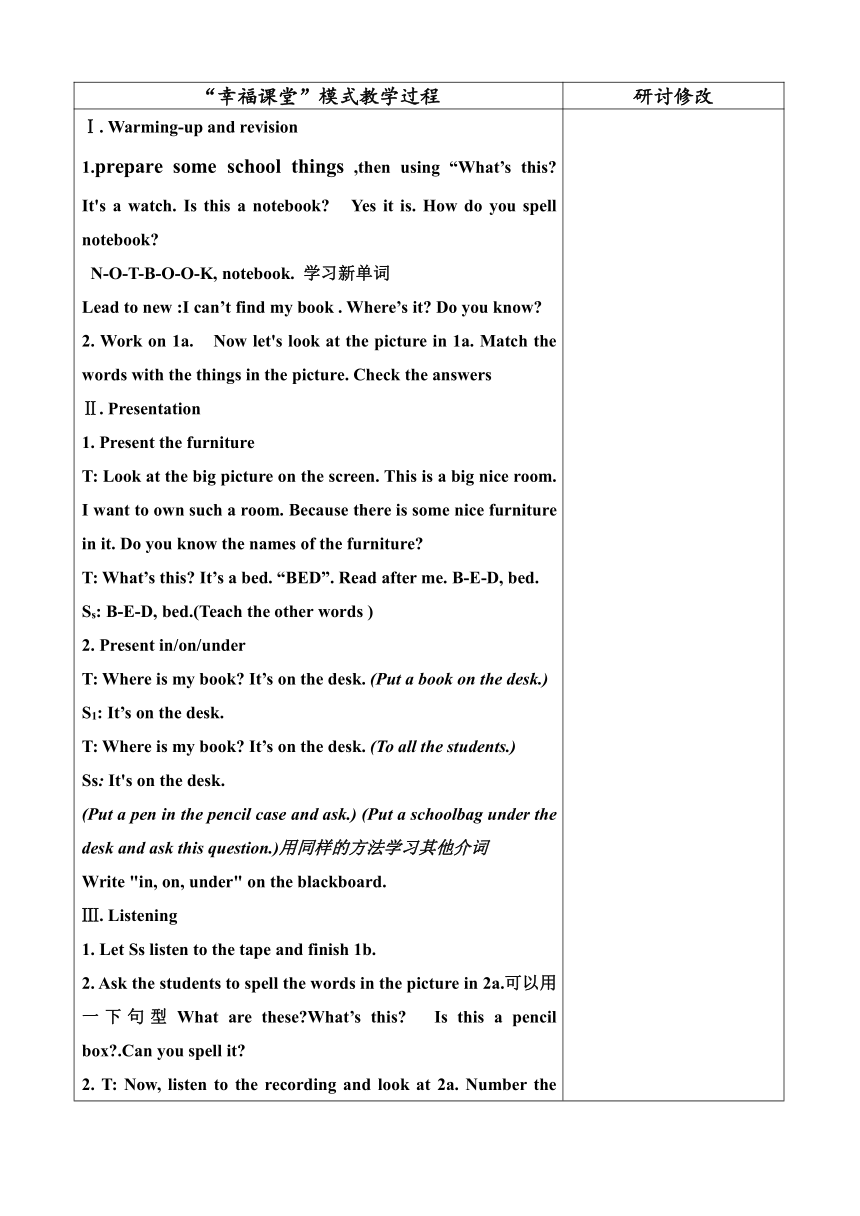Unit7 Where’s my schoolbag—Section A(1a-2c)教案(表格式)
文档属性
| 名称 | Unit7 Where’s my schoolbag—Section A(1a-2c)教案(表格式) |  | |
| 格式 | doc | ||
| 文件大小 | 46.5KB | ||
| 资源类型 | 教案 | ||
| 版本资源 | 鲁教版 | ||
| 科目 | 英语 | ||
| 更新时间 | 2022-09-02 16:22:33 | ||
图片预览


文档简介
集体备课教案
学科: 英语
课题 六年级英语上unit7SA(1a-2c) 课型 New 审核签字 序号 39
学习目标与重难点 1. 语言知识目标:1) 能掌握下列词汇:where----head 2) 能掌握以下句型:① —Where's… —It's in/on/under…② —Where're… —They're in/on/under… ③ —Is the …in/on/under… —Yes, it is./ No, it isn't. ④ —Are the …in/on/under… —Yes, they are. /No, they aren't. 2) 学会运用方位介词in, on, under和where句型表述物品所在的位置。2. 情感态度价值观目标:培养学生整齐地摆放自己物品的生活习惯。二、教学重难点1) 方位介词 in , on , under , behind的用法。2) Where的特殊疑问句和Is . . . 、Are…一般疑问句及其肯定和否定回答。1) 学会正确描述物品作在的位置;2) 学会询问自己或他人物品的具体位置; 恰当具体可测
媒体运用 课件,录音 整合点准确恰当
教学思路 用主题句型教学单词-听录音加深印象—学生小组练习(看着大屏幕上的图片)---用实物练习主题句型—当堂检测 具体明晰
导语设计 Look at the big picture on the screen. This is a big nice room. I want to own such a room. Because there is some nice furniture in it. Do you know the names of the furniture I can’t find my book . Where’s it Do you know 精炼灵活紧扣学习目标
板书设计 Unit7 Where’s my schoolbag 1. where, table, bed, bookcase, sofa, chair, desk, room 2. in, on, under 3. —Where is … —It's in/on/under… —Where are … —They're in/on/under… 4. —Are the books on the sofa —No, they aren't. They're on the table.—Is the schoolbag under the table —No, it isn't. It's on the sofa. 知识结构纲要化
“幸福课堂”模式教学过程 研讨修改
Ⅰ. Warming-up and revision 1.prepare some school things ,then using “What’s this It's a watch. Is this a notebook Yes it is. How do you spell notebook N-O-T-B-O-O-K, notebook. 学习新单词Lead to new :I can’t find my book . Where’s it Do you know 2. Work on 1a. Now let's look at the picture in 1a. Match the words with the things in the picture. Check the answersⅡ. Presentation1. Present the furnitureT: Look at the big picture on the screen. This is a big nice room. I want to own such a room. Because there is some nice furniture in it. Do you know the names of the furniture T: What’s this It’s a bed. “BED”. Read after me. B-E-D, bed.Ss: B-E-D, bed.(Teach the other words )2. Present in/on/underT: Where is my book It’s on the desk. (Put a book on the desk.)S1: It’s on the desk.T: Where is my book It’s on the desk. (To all the students.)Ss: It's on the desk. (Put a pen in the pencil case and ask.) (Put a schoolbag under the desk and ask this question.)用同样的方法学习其他介词Write "in, on, under" on the blackboard. Ⅲ. Listening1. Let Ss listen to the tape and finish 1b. 2. Ask the students to spell the words in the picture in 2a.可以用一下句型What are these What’s this Is this a pencil box .Can you spell it 2. T: Now, listen to the recording and look at 2a. Number the things from 1-6.T: Check the answer. (Students give the answer.)3. T: Now, listen again. Let’s do 2b. Find out where are the things from 2a Number the things in the pictures [1-6]. (Play the tape again and check the answer.)T: Who can answer S: The computer game is …/ The books are …/The pencil box is …/The schoolbag is…/The ruler is… /The keys are … Ⅳ. Pair work 1. Practice the conversation in 1a with your partner. 2. Ss practice the conversation. Then ask some pairs to act out the conversation. 3. Then make your own conversations using the words in the box (in/on/under). Ss may look at the picture in 1a and make their own conversations. They can also using school things around them to make their own conversations. 4. Ask some pairs to act out their conversations.Ⅵ. Pair workT: Look at the picture. Are the books on the sofa Ss: No, they aren't. They're on the table.T: Is the schoolbag under the table S: No, it isn't. It's on the sofa.…(Write the four sentences on the blackboard. Let the students ask and answer questions about the things in the picture in 2b.) Ⅶ. Role-play 1. Jack is a forgetful boy. He always doesn't know where his things are. Let's help him find his things.Match the things with the right places below. (Let Ss look at the screen. There are some things and some places) bag on his headmap on the sofahat on the bed in his grandparents' room 2. Ss read the conversation and match the things with the right places. 3. Check the answers. 4. Now practice the conversation with your partner. Then let some pairs act out the conversation. 5. 评价:(让学生们对自己的表现及语言表达能力进行自我评价,在小组内评价,然后进行评出最优秀的小组。并鼓励学生们下一次争取做最优秀的小组及个人。)Homework:
反思重建
学科: 英语
课题 六年级英语上unit7SA(1a-2c) 课型 New 审核签字 序号 39
学习目标与重难点 1. 语言知识目标:1) 能掌握下列词汇:where----head 2) 能掌握以下句型:① —Where's… —It's in/on/under…② —Where're… —They're in/on/under… ③ —Is the …in/on/under… —Yes, it is./ No, it isn't. ④ —Are the …in/on/under… —Yes, they are. /No, they aren't. 2) 学会运用方位介词in, on, under和where句型表述物品所在的位置。2. 情感态度价值观目标:培养学生整齐地摆放自己物品的生活习惯。二、教学重难点1) 方位介词 in , on , under , behind的用法。2) Where的特殊疑问句和Is . . . 、Are…一般疑问句及其肯定和否定回答。1) 学会正确描述物品作在的位置;2) 学会询问自己或他人物品的具体位置; 恰当具体可测
媒体运用 课件,录音 整合点准确恰当
教学思路 用主题句型教学单词-听录音加深印象—学生小组练习(看着大屏幕上的图片)---用实物练习主题句型—当堂检测 具体明晰
导语设计 Look at the big picture on the screen. This is a big nice room. I want to own such a room. Because there is some nice furniture in it. Do you know the names of the furniture I can’t find my book . Where’s it Do you know 精炼灵活紧扣学习目标
板书设计 Unit7 Where’s my schoolbag 1. where, table, bed, bookcase, sofa, chair, desk, room 2. in, on, under 3. —Where is … —It's in/on/under… —Where are … —They're in/on/under… 4. —Are the books on the sofa —No, they aren't. They're on the table.—Is the schoolbag under the table —No, it isn't. It's on the sofa. 知识结构纲要化
“幸福课堂”模式教学过程 研讨修改
Ⅰ. Warming-up and revision 1.prepare some school things ,then using “What’s this It's a watch. Is this a notebook Yes it is. How do you spell notebook N-O-T-B-O-O-K, notebook. 学习新单词Lead to new :I can’t find my book . Where’s it Do you know 2. Work on 1a. Now let's look at the picture in 1a. Match the words with the things in the picture. Check the answersⅡ. Presentation1. Present the furnitureT: Look at the big picture on the screen. This is a big nice room. I want to own such a room. Because there is some nice furniture in it. Do you know the names of the furniture T: What’s this It’s a bed. “BED”. Read after me. B-E-D, bed.Ss: B-E-D, bed.(Teach the other words )2. Present in/on/underT: Where is my book It’s on the desk. (Put a book on the desk.)S1: It’s on the desk.T: Where is my book It’s on the desk. (To all the students.)Ss: It's on the desk. (Put a pen in the pencil case and ask.) (Put a schoolbag under the desk and ask this question.)用同样的方法学习其他介词Write "in, on, under" on the blackboard. Ⅲ. Listening1. Let Ss listen to the tape and finish 1b. 2. Ask the students to spell the words in the picture in 2a.可以用一下句型What are these What’s this Is this a pencil box .Can you spell it 2. T: Now, listen to the recording and look at 2a. Number the things from 1-6.T: Check the answer. (Students give the answer.)3. T: Now, listen again. Let’s do 2b. Find out where are the things from 2a Number the things in the pictures [1-6]. (Play the tape again and check the answer.)T: Who can answer S: The computer game is …/ The books are …/The pencil box is …/The schoolbag is…/The ruler is… /The keys are … Ⅳ. Pair work 1. Practice the conversation in 1a with your partner. 2. Ss practice the conversation. Then ask some pairs to act out the conversation. 3. Then make your own conversations using the words in the box (in/on/under). Ss may look at the picture in 1a and make their own conversations. They can also using school things around them to make their own conversations. 4. Ask some pairs to act out their conversations.Ⅵ. Pair workT: Look at the picture. Are the books on the sofa Ss: No, they aren't. They're on the table.T: Is the schoolbag under the table S: No, it isn't. It's on the sofa.…(Write the four sentences on the blackboard. Let the students ask and answer questions about the things in the picture in 2b.) Ⅶ. Role-play 1. Jack is a forgetful boy. He always doesn't know where his things are. Let's help him find his things.Match the things with the right places below. (Let Ss look at the screen. There are some things and some places) bag on his headmap on the sofahat on the bed in his grandparents' room 2. Ss read the conversation and match the things with the right places. 3. Check the answers. 4. Now practice the conversation with your partner. Then let some pairs act out the conversation. 5. 评价:(让学生们对自己的表现及语言表达能力进行自我评价,在小组内评价,然后进行评出最优秀的小组。并鼓励学生们下一次争取做最优秀的小组及个人。)Homework:
反思重建
同课章节目录
- Unit 1 Good morning
- Section A
- Section B
- Unit 2 What's this in English?
- Section A
- Section B
- Unit 3 What color is it?
- Section A
- Section B
- Unit 4 My name's is Gina
- Section A
- Section B
- Unit 5 This is my siste
- Section A
- Section B
- Unit 6 Is this your pencil?
- Section A
- Section B
- Unit 7 Where's my schoolbag?
- Section A
- Section B
- Unit 8 Do you have a soccer ball?
- Sectioan A
- Sectioan B
- Unit 9 Do you like bananas?
- Section A
- Section B
- Unit 10 How much are these socks?
- Section A
- Section B
